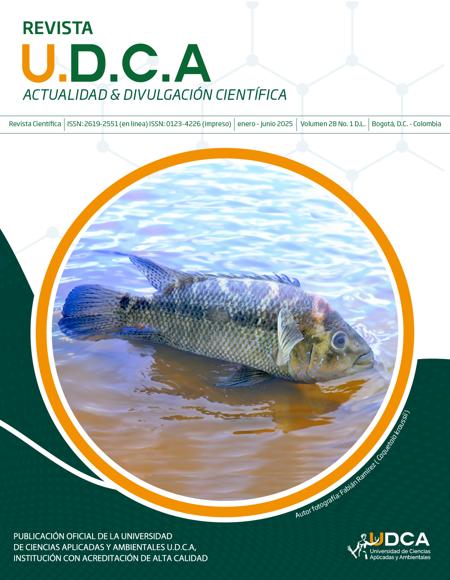Uso de aditivos nutraceúticos mejora el desarrollo intestinal y la salud productiva durante el post destete porcino
The use of nutraceutical additives improves intestinal development and productive health during post-weaning in pigs
Contenido principal del artículo
Resumen
El mantenimiento de la salud intestinal durante el período post destete representa un desafío en la porcicultura, debido a la concurrencia de diversos estresores que afectan el rendimiento productivo y predisponen a trastornos gastrointestinales. Ante la necesidad de reducir el uso de antibióticos promotores del crecimiento, los aditivos nutracéuticos se consideran como una alternativa viable, por lo tanto, se evaluó el efecto de diferentes aditivos nutracéuticos sobre las variables morfométricas intestinales y su relación con el desempeño productivo en lechones. Se utilizaron 240 lechones destetados a los 21 días de edad, asignados aleatoriamente a seis tratamientos: D1, dieta basal comercial; D2, D1 + bacitracina de zinc (150 ppm); D3, D1 + maltodextrina (550 ppm); D4, D1 + fructooligosacáridos (300 ppm); D5, D1 + aceite esencial de Lippia origanoides (69 ppm) y D6, D1 + humatos de sodio (750 ppm). Se evaluaron parámetros zootécnicos y se recolectaron muestras de duodeno y yeyuno en los días 0, 15 y 30, para análisis morfométrico y determinación de pH intestinal. Los lechones que recibieron D4 y D5 presentaron una mejora de 0,08 y 0,07 puntos en la conversión alimenticia, en comparación con D2. Además, se observó un incremento en el desarrollo morfométrico intestinal de hasta el 31 y 27 %, a los días 15 y 30, respectivamente. En conclusión, la suplementación con fructooligosacáridos o aceite esencial de L. origanoides mejora la integridad intestinal y el rendimiento productivo, constituyendo una alternativa eficaz al uso de antibióticos en la alimentación post destete.
Palabras clave:
Descargas
Datos de publicación
Perfil evaluadores/as N/D
Declaraciones de autoría
- Sociedad académica
- Universidad de Ciencias Aplicadas UDCA
- Editorial
- Universidad de Ciencias Aplicadas y Ambientales U.D.C.A
Detalles del artículo
Referencias (VER)
ÁNGEL-ISAZA, J.A.; HERRERA FRANCO, V.; LÓPEZ-HERRERA, A.; PARRA-SUESCUN, J.E. 2024. Nutraceutical additives modulate microbiota and gut health in post-weaned piglets. Veterinary Sciences. 11(8):332. https://doi.org/10.3390/vetsci11080332
AZAD, M.A.K.; GAO, J.; MA, J.; LI, T.; TAN, B.; HUANG, X.; YIN, J. 2020. Opportunities of prebiotics for the intestinal health of monogastric animals. Animal Nutrition. 6(4):379–388. https://doi.org/10.1016/j.aninu.2020.08.001
BARRERA-BARRERA, H.M.; RODRÍGUEZ-GONZÁLEZ, S.P.; TORRES-VIDALES, G. 2014. Efectos de la adición de ácido cítrico y un probiótico comercial en el agua de bebida, sobre la morfometría del duodeno y parámetros zootécnicos en pollo de engorde. Orinoquia. 18(2):52. https://doi.org/10.22579/20112629.306
CANADIAN COUNCIL ON ANIMAL CARE. 2009. Guidelines on: the care and use of farm animals in research, teaching and testing Canadian Council on Animal Care in science. Volumen 1. CCAC. Canada. 162p. Disponible desde Internet en: https://ccac.ca/Documents/Standards/Guidelines/Farm_Animals.pdf
CHENG, C.; XIA, M.; ZHANG, X.; WANG, C.; JIANG, S.; PENG, J. 2018. Supplementing oregano essential oil in a reduced-protein diet improves growth performance and nutrient digestibility by modulating intestinal bacteria, intestinal morphology, and antioxidative capacity of growing-finishing pigs. Animals. 8(9):159. https://doi.org/10.3390/ani8090159
CIRO GALEANO, J.A.; LÓPEZ HERRERA, A.; PARRA SUESCÚN, J. 2016. The probiotic Enterococcus faecium modifies the intestinal morphometric parameters in weaning piglets. Revista Facultad Nacional de Agronomía Medellín. 69(1):7803-7811. https://doi.org/10.15446/RFNA.V69N1.54748
CSERNUS, B.; CZEGLÉDI, L. 2020. Physiological, antimicrobial, intestine morphological, and immunological effects of fructooligosaccharides in pigs. Archives Animal Breeding. 63(2):325-335. https://doi.org/10.5194/AAB-63-325-2020
DIEGUEZ, S.N.; DECUNDO, J.M.; MARTÍNEZ, G.; AMANTO, F.A.; BIANCHI, C.P.; PÉREZ GAUDIO, D.S.; SORACI, A.L. 2022. Effect of dietary oregano (Lippia origanoides) and clover (Eugenia caryophillata) essential oilsʼ formulations on intestinal health and performance of pigs. Planta Medica. 88(3-4):324-335. https://doi.org/10.1055/a-1698-8469
ERIKSEN, E.Ø.; KUDIRKIENE, E.; CHRISTENSEN, A.E.; AGERLIN, M.V.; WEBER, N.R.; NØDTVEDT, A.; NIELSEN, J.P.; HARTMANN, K.T.; SKADE, L.; LARSEN, L.E.; PANKOKE, K.; OLSEN, J.E.; JENSEN, H.E.; PEDERSEN, K.S. 2021. Post-weaning diarrhea in pigs weaned without medicinal zinc: risk factors, pathogen dynamics, and association to growth rate. Porcine Health Management. 7(1):54. https://doi.org/10.1186/s40813-021-00232-z
GIANNENAS, I.; TZORA, A.; SARAKATSIANOS, I.; KARAMOUTSIOS, A.; SKOUFOS, S.; PAPAIOANNOU, N.; ANASTASIOU, I.; SKOUFOS, I. 2016. The Effectiveness of the use of oregano and laurel essential oils in chicken feeding. Annals of Animal Science. 16(3). https://doi.org/10.1515/aoas-2015-0099
HERRERA FRANCO, V.; PARDO CARRASCO, S.; PARRA SUESCÚN, J. 2022. Antimicrobials added to the feed of weaned piglets at two ages improves the molecular expression of intestinal barrier proteins. Animal Production Science. 62(6):511–520. https://doi.org/10.1071/AN21027
INTERNATIONAL COUNCIL FOR LABORATORY ANIMAL SCIENCE, ICLAS. 2012. International guiding principles for biomedical research involving animals. Consejo de Organizaciones Internacionales de las Ciencias Médicas- Consejo Internacional para la Ciencia de Animales de Laboratorio. 4p. Disponible desde Internet en: https://grants.nih.gov/grants/olaw/guiding_principles_2012.pdf
KIERNAN, D.P.; O’DOHERTY, J.V.; SWEENEY, T. 2023. The effect of prebiotic supplements on the gastrointestinal microbiota and associated health parameters in pigs. Animals. 13(19):3012. https://doi.org/10.3390/ani13193012
KIM, S.W.; DUARTE, M.E. 2021. Understanding intestinal health in nursery pigs and the relevant nutritional strategies. Animal Bioscience. 34(3):338. https://doi.org/10.5713/AB.21.0010
KOGUT, M.H.; YIN, X.; YUAN, J.; BROOM, L. 2017. Gut health in poultry. CAB Reviews: Perspectives in Agriculture, Veterinary Science, Nutrition and Natural Resources. Reino Unido. https://doi.org/10.1079/PAVSNNR201712031
LATA, M. 2022. Weaned pig: Influencing dietary factors for functionality of small intestine. Vigyan Varta. 3(1):7-11.
LIU, L.; CHEN, D.; YU, B.; YIN, H.; HUANG, Z.; LUO, Y.; ZHENG, P.; MAO, X.; YU, J.; LUO, J.; YAN, H.; HE, J. 2020. Fructooligosaccharides improve growth performance and intestinal epithelium function in weaned pigs exposed to enterotoxigenic Escherichia coli. Food & Function. 11(11):9599–9612. https://doi.org/10.1039/D0FO01998D
MADRID-GARCÉS, T.A.; LÓPEZ-HERRERA, A.; PARRA-SUESCÚN, J. 2018. La ingesta de aceite esencial de orégano (Lippia origanoides) mejora la morfología intestinal en Broilers. Archivos de Zootecnia. 66(254):287-299. http://dx.doi.org/10.21071/az.v0i0.3876
MAYA-ORTEGA F.C.; ÁNGEL-ISAZA, J.A.; MARTÍNEZ-MORALES, B.C.; PARRA-SUESCÚN, J.E. 2021. Aceite esencial de orégano (Lippia origanoides) mejora parámetros productivos y metabólitos sanguíneos en lechones. Biotecnología en el Sector Agropecuario y Agroindustrial. 19(2):82-93. https://doi.org/10.18684/bsaa.v19.n2.2021.1547
MO, K.; LI, J.; LIU, F.: XU, Y.; HUANG, X.; NI, H. 2022. Superiority of microencapsulated essential oils compared with common essential oils and antibiotics: effects on the intestinal health and gut microbiota of weaning piglet. Frontiers in Nutrition. 8:808106. https://doi.org/10.3389/fnut.2021.808106
MOHITI-ASLI, M.; GHANAATPARAST-RASHTI, M. 2018. Comparing the effects of a combined phytogenic feed additive with an individual essential oil of oregano on intestinal morphology and microflora in broilers. Journal of Applied Animal Research. 46(1):184-189. https://doi.org/10.1080/09712119.2017.1284074
NGUYEN, D.T.N.; LE, N.H.; PHAM, V.V.; EVA, P.; ALBERTO, F.; LE, H.T. 2021. Relationship between the ratio of villous height: crypt depth and gut bacteria counts as well production parameters in broiler chickens. The Journal of Agriculture and Development. 20(03):1–10. https://doi.org/10.52997/jad.1.03.2021
PADILLA PÉREZ, M. 2007. Manual de porcicultura. Ministerio de Agricultura y Ganadería, San José, Costa Rica. 96p. Disponible desde Internet en: https://www.mag.go.cr/bibliotecavirtual/l01-9306.pdf
PATIÑO F., F.; HERRERA F., V.; LÓPEZ D., D.; PARRA S., J. 2019. Blood metabolites and zootechnical parameters in piglets weaned at two ages and with the addition of antimicrobials in the feed. Revista de Investigaciones Veterinarias Del Peru. 30(2):612–623. https://doi.org/10.15381/rivep.v30i2.14887
PARRA ALARCÓN, E.A.; HIJUITL VALERIANO, T.D.J.; MARISCAL LANDÍN, G.; REIS-DE SOUZA, T.C. 2022. Concentrado de proteína de papa: una posible alternativa al uso de antibióticos en las dietas para lechones destetados. Revisión. Revista Mexicana de Ciencias Pecuarias. 13(2):510–524. https://doi.org/10.22319/rmcp.v13i2.5980
PENG, Q.Y.; LI, J.D.; LI, Z.; DUAN, Z.Y.; WU, Y.P. 2016. Effects of dietary supplementation with oregano essential oil on growth performance, carcass traits and jejunal morphology in broiler chickens. Animal Feed Science and Technology. 214:148-153. https://doi.org/10.1016/j.anifeedsci.2016.02.010
REIS-DE SOUZA, C.T.; LANDÍN, M.G.; GARCÍA, K.E. 2010. Algunos factores fisiológicos y nutricionales que afectan la incidencia de diarreas posdestete en lechones. Veterinaria México.41(4):275-288.
REIS-DE SOUZA, T.; CARRILLO G.D.J.M.; BARREYRO, A.A.; LANDÍN, G.M. 2005. Effect of different cereals on intestinal villous morphology in weaned piglets. Técnica Pecuaria en México. 43(3):309-321.
ROSTAGNO, H.S. 2017. Tablas brasileñas para aves y cerdos. Cuarta edición. Departamento de Zootecnia, UFV. Brasil. 488p.
RSTUDIO TEAM. 2020. RStudio: Integrated Development for R. RStudio, PBC. https://posit.co/blog/rstudio-pbc/
SANTOS, T.G.; FERNANDES, S.D.; DE OLIVEIRA ARAÚJO, S.B.; FELICIONI, F.; DE MÉRICI DOMINGUES E PAULA, T.; CALDEIRA-BRANT, A.L.; FERREIRA, S.V.; DE PAULA NAVES, L.; DE SOUZA, S.P.; CAMPOS, P.H.R.F.; CHIARINI-GARCIA, H.; DIAS, A.L.N.A.; DE ALMEIDA, F.R.C.L. 2022. Intrauterine growth restriction and its impact on intestinal morphophysiology throughout postnatal development in pigs. Scientific Reports. 12(1):11810. https://doi.org/10.1038/s41598-022-14683-z
WANG, M.; YANG, C.; WANG, Q.; LI, J.; HUANG, P.; LI, Y.; DING, X.; YANG, H.; YIN, Y. 2020. The relationship between villous height and growth performance, small intestinal mucosal enzymes activities and nutrient transporters expression in weaned piglets. Journal of Animal Physiology and Animal Nutrition. 104(2):606–615. https://doi.org/10.1111/JPN.13299
YANG, X.; XIN, H.; YANG, C.; YANG, X. 2018. Impact of essential oils and organic acids on the growth performance, digestive functions and immunity of broiler chickens. Animal Nutrition. 4(4):388–393. https://doi.org/10.1016/J.ANINU.2018.04.005
ZHAI, H.; LIU, H.; WANG, S.; WU, J.; KLUENTER, A.M. 2018. Potential of essential oils for poultry and pigs. Animal Nutrition. 4(2):179–186. https://doi.org/10.1016/J.ANINU.2018.01.005
ZHAO, F.; XIA, Z. 2019. Application of FOS and CPP in intestinal health of Weaned Piglets. E3S Web of Conferences. 131. https://doi.org/10.1051/e3sconf/201913101077
ZHENG, L.; DUARTE, M.E.; SEVAROLLI LOFTUS, A.; KIM, S.W. 2021. Intestinal health of pigs upon weaning: Challenges and nutritional intervention. Frontiers in Veterinary Science. 8:91. https://doi.org/10.3389/fvets.2021.628258
ZOU, Y.; XIANG, Q.; WANG, J.; PENG, J.; WEI, H. 2016. Oregano essential oil improves intestinal morphology and expression of tight junction proteins associated with modulation of selected intestinal bacteria and immune status in a pig model. BioMed Research International. 2016(1):5436738. https://doi.org/10.1155/2016/5436738







